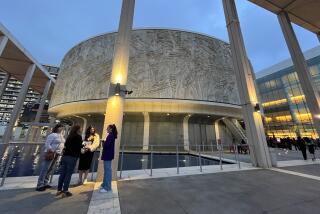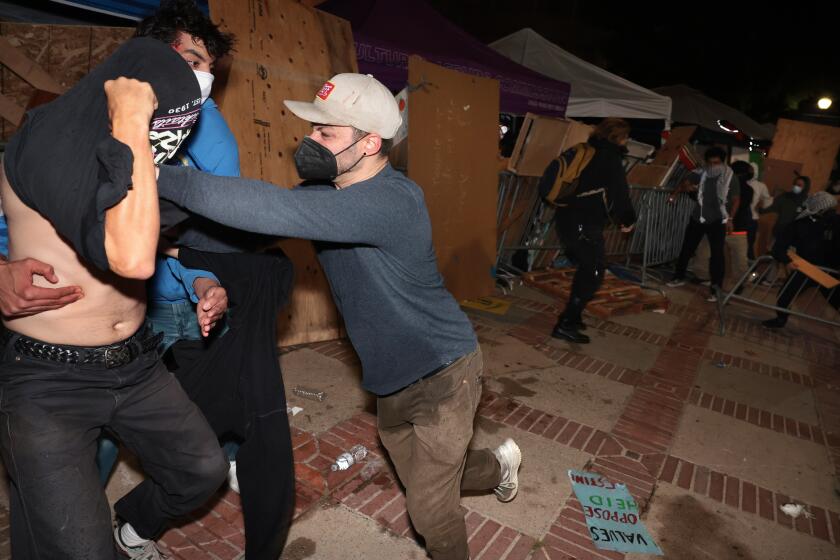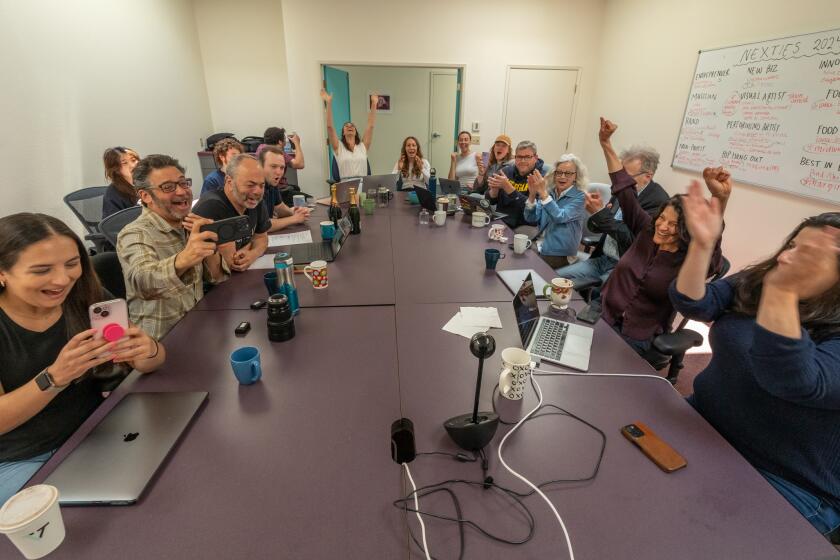Plucky Theatre Tribe gets a gift on its 10th birthday
When you’re running a matchbook-size theater that contains only 38 seats, it quickly becomes obvious that certain productions are just not physically possible -- extravagant musicals, historical epics and opulent period comedies are just some of the genres that are guaranteed to bust the fourth wall and spill out of the proscenium.
Theatre Tribe‘s micro space in North Hollywood isn’t just intimate, it’s arguably a claustrophobe’s nightmare. But this scrappy company, which recently turned 10 years old, has learned to turn its severe spatial limitations into a creative advantage.
Specializing in modest, character-driven plays that depend on a strong audience-actor connection, Theatre Tribe has developed a reputation for quality and top-notch acting, winning a handful of local awards in the process. With its current production of Martin McDonagh’s “A Skull in Connemara” (extended through March 28), the company has the biggest commercial and critical hit of its decade-long existence.
The brain behind the operations belongs to Stuart Rogers, a compact and energetic man who describes himself as a “born and bred theater animal.” An acting instructor by profession, Rogers founded Theatre Tribe in 1999 and ran it from its original Hollywood location before moving the company to North Hollywood in 2001.
Rogers, who serves as artistic director, says his mission is to produce L.A. premieres of contemporary plays, and a glance at Theatre Tribe’s history reveals a preference for big-name theater talent. In recent years, the company has scored the local premieres of works by Richard Greenberg, Paula Vogel, Craig Wright and David Mamet.
On the company’s to-avoid list: plays that have become regional theater standbys. “I love Lanford Wilson, but do we really need to see ‘Burn This’ again? It’s been done so many times before,” Rogers says.
He adds that the space sometimes dictates what he can produce: “We can’t do anything that is elegant or grand. Definitely no plays set in Beverly Hills. We couldn’t have a mansion set on this stage.”
In many ways, “A Skull in Connemara” (which Rogers directed) typifies the kind of drama audiences can expect from the company -- witty, entertaining and physically small-scaled. The production is also an excellent example of the stage crew’s resourceful and imaginative use of the tiny space.
Set in Galway, Ireland -- a land where whiskey and the f-word flow with equal freedom -- “Skull” focuses on a widowed gravedigger named Mick Dowd (Morlan Higgins) whose job is to dig up old bones to make room for fresh bodies. One night, he’s assigned to work on his own wife’s grave, and through a series of late-night conversations he ends up exhuming long-dead rumors about his own involvement in her untimely demise.
Most of the play takes place in Mick’s run-down shack, but a key scene change transforms the set into a misty, gothic graveyard. The transition -- a genuine “wow” moment -- takes place in full view of the audience and involves the lowering of the upstage wall using a series of manual pulleys.
Set designer Jeff McLaughlin says he went through six design ideas before settling on the simplest one. “I thought about it backward -- first I concentrated on the graveyard and once I knew how that looked, the rest fell into place,” he explains.
With the audience sitting close enough to almost touch the scenery, the company can’t risk fudging the details. The play features two 6-foot-deep graves filled with real dirt. Or- iginally they used cocoa mulch, but after the first few performances they found that it putrefied under the hot stage lights, so they switched to potting soil.
For a scene in which the main characters smash a series of skulls in a drunken fit, the crew creates fresh plaster-of-Paris molds for each performance, painting and sanding each one to ensure that they look like they’ve been in the ground for several years.
It gets even more detailed: to facilitate the smashing of the bones, the crew experimented with adding baking soda to the plaster molds, only to discover that it made the skulls too brittle. (The solution? Casting the molds with a thinner layer of plaster so that they shatter on contact.)
The only thing smaller than the space at Theatre Tribe is the budget, which leaders estimate is around $50,000 per year. Much of that goes toward the lease for the building, with the rest covering the actual productions. (The company has three staff workers.)
Having only 38 seats to fill each night makes the marketing effort that much easier, but selling tickets still takes a lot out of the company.
“It’s difficult when you can’t do a subscription season because the house is so small. It’s all single-ticket buyers, and so each show is like starting all over again,” says Sara Shapley, the company’s general manager. She adds that most of the company’s shows manage to eke out a small financial gain.
The popular success of “Skull” is the result of a “perfect storm,” say company leaders. The play has a rambunctious sense of humor that appeals to younger audiences. This production also comes at a time when interest in McDonagh’s work is rising in L.A., no doubt helped by his recent Oscar nomination for “In Bruges.”
In fact, “Skulls” has whetted the company’s appetite to produce more of McDonagh’s plays, particularly “The Lieutenant of Inishmore.” But the Mark Taper Forum currently has its hands on that work, having originally slated a production for this spring only to push it back until next season.
Future projects at Theatre Tribe include producing its first Equity season and ramping up its writers’ workshops. For now at least, the company is comfortable in its cozy digs, content to create theater in a space that could fit snugly inside the men’s lavatory at the Ahmanson.
“We’re devoted to using our limited resources to produce great art,” says Jeff Kerr McGivney, a founding company member and a cast member of “Skull.” He describes Rogers’ directing style as “relentless and laid-back at the same time. He knows exactly what he wants and he lets things happen as they may.”
McGivney adds: “We’re a small company, and we’re slow in producing stuff, but in the end it’s the quality that’s most important to us.”
More to Read
Start your day right
Sign up for Essential California for news, features and recommendations from the L.A. Times and beyond in your inbox six days a week.
You may occasionally receive promotional content from the Los Angeles Times.







